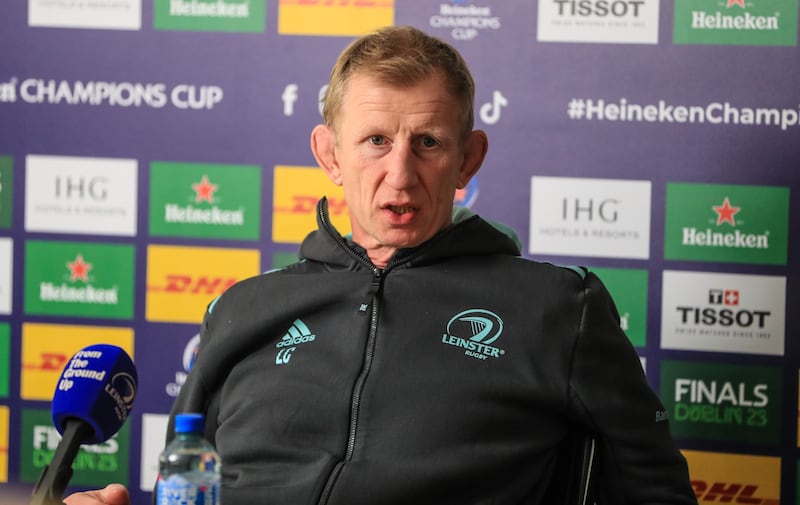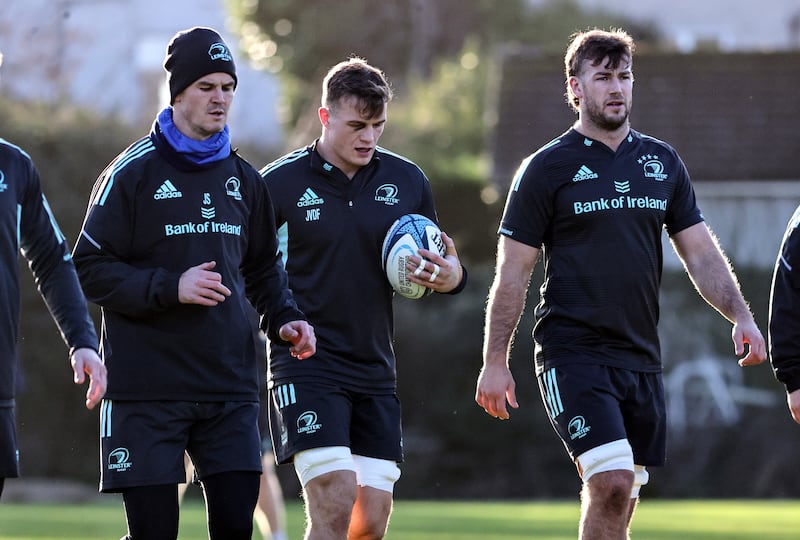Mick Dawson was barely a month into what would become a 21-year tenure as Leinster chief executive when the province met Munster in the inaugural Celtic League final in December 2001.
“I was only in the door a wet week and 35,000 people turned up, and people were chanting ‘Leinster’. My old man would say he never thought he would here that. Roar for Leinster?” says Dawson with a laugh.
Less than nine years on, Leinster hosted Munster in their first game at the new Aviva Stadium, a full house generating €2 million. “The rivalry has evolved, and they’ll pack out Thomond Park on Monday. It’s great for both franchises.”
Fittingly, Dawson’s final home game as Leinster boss was the October meeting between the two provinces at the Aviva, when 45,000-plus turned up, and he cites the 2006 Heineken Cup semi-final at the old Lansdowne Road as a turning point.
RM Block
“Munster beat us out the gate, on and off the pitch. A sea of red everywhere.”
And that galvanised Leinster team and supporters alike?
“It galvanised me, and our coaching staff. They said we weren’t good enough on the pitch and we said we weren’t good enough off the pitch.”
You need a bit of luck too. And good coaches need good players, and we’ve always had good players
The following season, the Leinster v Munster game moved from Donnybrook to Lansdowne Road. They’d sold 10,000 tickets come match-day and so opted not to open all the turnstiles. The official attendance was 27,252, but Dawson reckons there might have been 35,000 there. “We had to open the gates and let almost 10,000 people in for nothing. So that was a big wake-up call. It was a different world after that.”
Then came the 2009 Heineken Cup semi-final at Croke Park, witnessed by 82,208. Leinster won 25-6 en route to the first of four Champions Cups.
“Both on and off the pitch we’d grown, and the rest is history.”
So, in some respects, Munster were Leinster’s biggest source of inspiration?
“Absolutely. You were looking at them and thinking: ‘What are they doing that we can’t do?’ And we’d everything going for us, capital city and all that, and you knew secretly that they were laughing at you.”
Dawson also credits Leo Cullen for demanding change after his sojourn at Leicester. “But it was quiet evolution rather than revolution, and we’ve probably got to up our game again now.

“But you need a bit of luck too. And good coaches need good players, and we’ve always had good players,” he says, pointing to the “extraordinary” schools system.
“What they do is un-buyable. It’s a funny model. We’re one of the few clubs in the world in which nearly 90 per cent of the players are homegrown, so the overseas’ signings have to be quality people and good players.”
He accepts that there are more Shane Horgans, Sean O’Briens and Tadhg Furlongs out there, which is why Leinster have centres of excellence in Donnybrook and Carlow, and work closely with Kings Hospital school and Dundalk IT “so that kids who don’t get exposed to the schools system can get to places where they can train without having to come to Dublin. That’s hugely important because you are in a battle with the FAI and the GAA for the hearts and minds of those kids.”

In all of this, the flagship and the financial engine of Leinster rugby is the senior team. “But it’s like an iceberg because there’s an awful lot behind the scenes to actually produce that. In my opinion, the most important person in the Leinster organisation is the head coach. He sets and drives the standards.”
The transformation off the pitch has been equally stark, from Friday nights in Donnybrook to the RDS from the 2007-08 season.
“Everyone said they loved the Donnybrook experience but one of the best things that Leinster ever did was move to the RDS. It’s a great location, a great facility, great surface, good floodlights. Hopefully the Anglesea stand will get redeveloped soon and I think it will be a world-class facility then.”
The move wasn’t without its hitches. Leinster’s first game was against Edinburgh with a 5.30pm kick-off, but the RDS didn’t have floodlights, much less a grandstand roof.
“Conor Hanratty was our marketing man and a driving force behind the RDS move. I said: ‘Conor, we can’t play in the evenings, we’ve no floodlights.’ He said: ‘Don’t worry Mick, I’ll get floodlights’,” recalls Dawson, mimicking Hanratty’s gravelly voice.
“Three hours to kick-off they still hadn’t arrived before a truck from England via Rosslare pulled in and parked behind the Anglesea Road stand. A big crane appeared above the stand with the lights but you could hardly see from one end of the pitch to the other. John D O’Brien in RTÉ said to me: ‘This can’t happen.’ I pleaded with him and the next time we had two sets of floodlights. They were the early days. There were huge logistical difficulties.”
Dawson built strong relationships with his “very proactive” RDS counterpart Michael Duffy, and his successor Geraldine Ruane, as Leinster successfully transitioned from the 6,500 capacity Donnybrook, now Energia Park, to the 18,500-capacity RDS, of whom 17,000 are seated. There were no season ticket holders in 2001, whereas there are 12,000 now. Leinster’s budget has risen from €1.5 million to €18 million, the playing squad from 30 to 46, and with 50-plus development officers, Leinster now employs almost 200 people.
The IRFU had initially voted against professionalism but Dawson credits it with having the foresight to go down the provincial route.
“If you look at the model in England and Wales now, unless you have very deep pockets and are well organised, it won’t last. The IRFU underwrote the costs for all the provinces. The right decision at the time.”
As for the training facilities, Dawson simply says: “It’s night and day.”
Back then, the senior team had a pitch and “a very basic gym” in Old Belvedere, while the staff operated from a Portakabin at the Old Wesley end of Donnybrook where the centre of excellence how houses the academy, under-age and women’s sections. Leinster’s headquarters have moved, via two further locations in Donnybrook, to University College Dublin, as have the squad, via Riverview gym in Clonskeagh, thanks to the investment of businessman David Shubotham.
“Without him it wouldn’t have happened,” admits Dawson. “And then the centre of excellence was thanks to Paul Coulson, and his brother-in-laws David and Niall Wall, and the government and the IRFU helped out, and then Denis O’Brien helped me with bringing Johnny Sexton home.”
He hails the vision of Hugh Brady, then president of UCD, as well as head of facilities Dominic O’Keefe and the late Brian Mullins, head of sport, and Éamonn Ceannt, for the move there. He also insists on mentioning Eleanor Ryan, who he worked with for 20 years, and Philip Lawlor.
Dawson’s family are so steeped in Lansdowne – his grandfather Michael, father Jack and brother Mark are all past presidents – that when he considered an approach from DLSP rugby club in Kilternan after leaving Catholic University School (CUS), his mother Sally responded: “And where will you live?”
A hooker, he captained and coached at various levels in Lansdowne, then managed the firsts and was director of rugby, so when asked to be club president in the club’s 150th year, he had to accept.
“I was delighted to be asked. I wish the first team would win a few more matches. But apart from there’s a nice family tradition there.”
To celebrate its 150th year, a fascinating book written by Professor Ivan McGrath is as much a history of Ireland in the late 1800s and early 1900s. For example, 73 members of Lansdowne lost their lives in the first World War. The club erected a memorial to commemorate them, but it only featured 42 names, as the other 31 hadn’t paid their subs. “That’s a true story,” says Dawson.
There’s also been a gala ball attended by 1,000 people in the Burlington Hotel, and there will be a business lunch with 400 people at the RDS on January 20th prior to playing UCD in the AIL and a game against the Irish Universities which has to be rearranged, as well as a golf outing in late May. He loved every day working in Leinster, but he’s back in the amateur game now, and it’s been eye-opening too.
“One thing that’s blown me away going into Lansdowne actually is the amount of volunteerism that is required to run a rugby club. Lansdowne are running five senior teams, one under-20 team, and we have 398 players in the mini/youths rugby from under-6s to under-18s.”
He shows me the latter list, all overseen by Brian Moran.
“He gets paid nothing and is on the executive. He’s a great man. And every club has them. It’s extraordinary.”





















